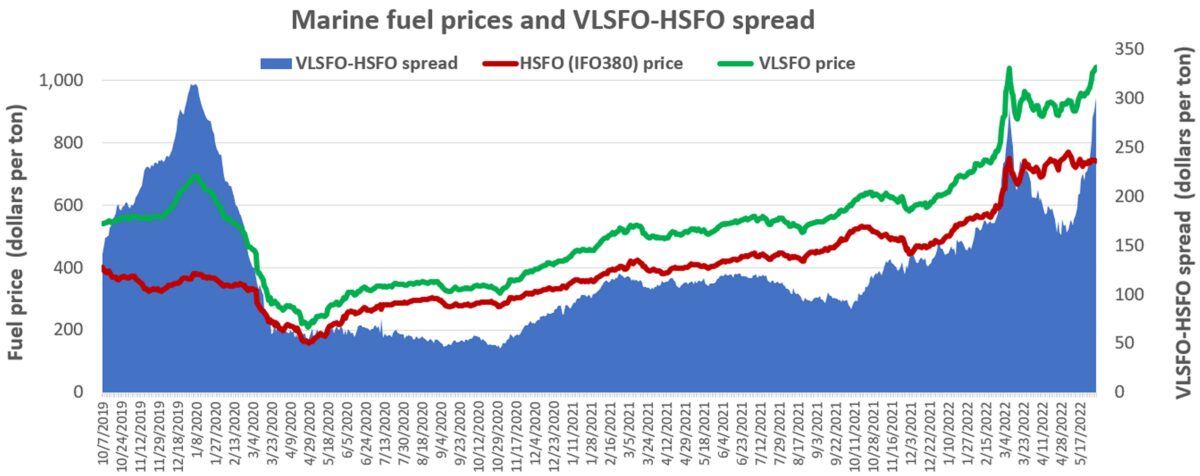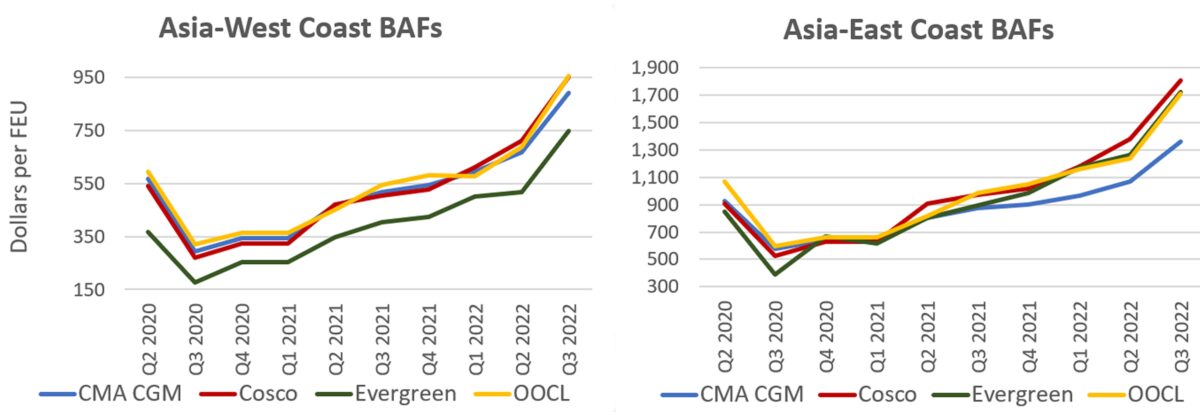It’s not just the price diesel, gasoline and jet fuel that’s way up. The price of the marine fuel consumed by the world’s container ships, tankers and bulkers is breaking records.
The price of very low sulfur fuel oil (VLSFO) — the 0.5% sulfur content fuel that powers most commercial ships — just exceeded the price spike that occurred soon after Russia’s invasion of Ukraine.
According to data from Ship & Bunker, the average VLSFO price at the world’s top 20 bunker (marine fuel) ports was $1,042 per ton on Wednesday, double its price a year ago. (The previous record was $1,040.50 per ton on March 9.)
Scrubber investments pay off
In January 2020, the IMO 2020 rule required ships to switch to VLSFO (or even more expensive marine gas oil) unless they had exhaust gas scrubbers or burned liquefied natural gas. Ships with scrubbers could continue to use cheaper high sulfur fuel oil (HSFO) with 3.5% sulfur content.
According to Ship & Bunker data, the average top-20-ports spread between VLSFO and HSFO jumped to a record $314.50 per ton on Jan. 7, 2020, amid the IMO rule transition. The spread then collapsed during the first year of COVID, sinking to a mere $45 per ton on Nov. 2, 2020. At that point, multi-million-dollar investments in scrubbers looked like a mistake.
No longer.
The spread is now flirting with a fresh high. HSFO known as IFO380 averaged $741.50 per ton on Wednesday at the top 20 ports. That put the VLSFO-HSFO spread at $300.50 per ton.

The situation is even more extreme at certain hubs. The VLSFO-HSFO spread at the key Asian bunkering hub of Singapore was $454.50 per ton.
At these spreads, scrubber investments are highly profitable.
Container shipping fuel effects
What does the marine fuel situation mean for vessel owners and operators?
In container shipping, fuel costs are passed along to cargo shippers with a lag effect via bunker adjustment factors (BAFs). These BAFs will be tacked on top of already record-high contract rates. The Q3 2022 BAFs of CMA CGM, Cosco, Evergreen and OOCL announced on Thursday jumped an average of 38% from this quarter and up 78% year on year.

Many of larger container ships handling longer-haul runs have scrubbers. According to Clarksons Platou Securities, 75% of on-the-water container ships with capacity of 17,000 twenty-foot equivalent units or more have scrubbers, as do 50% of 12,000- to 16,999-TEU ships (with significant further retrofits planned).
Lars Jensen, CEO of Vespucci Maritime, pointed out how ocean carriers with scrubber-equipped ships could profit from the spread.
Jensen recently wrote, “Most bunker fuel surcharges are linked to VLSFO price. This, de facto, means if a carrier has scrubbers on the vessels and BAFs linked to VLSFO, it is effectively getting paid by shippers for the high cost of VLSFO while at the same time buying the IFO380 [for] less and pocketing the difference.”
Commodity shipping fuel effects
In tanker and bulker shipping, the owner pays for fuel in a spot voyage deal. Thus, the higher the fuel price, the lower the spot rate net of fuel.
The current dynamic creates a huge advantage for owners that either have ships with scrubbers allowing them to burn HSFO, or have fuel-efficient “eco” designs allowing them to burn less VLSFO or HSFO.
In shipping sectors that are making money, like dry bulk and product tankers, owning scrubber-equipped and/or eco ships adds to profits. In a sector that’s losing money, like very large crude carriers (VLCCs), owning scrubber-equipped and/or eco ships reduces cash bleed.
Clarksons estimated on Thursday that an older non-eco, non-scrubber VLCC would hypothetically lose $7,400 per day in the spot market (on paper; in reality an owner would not do the voyage). In comparison, an eco, scrubber-equipped VLCC would earn $19,200 per day. Even in the best case, most VLCCs are still losing money; Clarksons put the all-in breakeven rate for a 5-year old VLCC at $34,000 per day.
In an example of a profitable sector, Clarksons put Thursday’s spot rate for non-eco, non-scrubber medium-range (MR) product tankers — the ships that carry gasoline, diesel and jet fuel — at $39,700 per day. Eco, scrubber-equipped MRs were at $50,100 per day.
Clarksons lists the breakeven for a 5-year old MR at $18,000 per day. These ships are raking in cash, especially those saving on fuel.
Click for more articles by Greg Miller
Related articles:
- Ship fuel spikes to historic $1,000/ton mark as war fallout worsens
- How invasion of Ukraine could ease shipping logjam off US ports
- Price of ship fuel surging, poised to eclipse all-time high
- Ship fuel price highest since 2013, ‘scrubber spread’ widens
- Yet another worry: Price of ship fuel is now highest since 2014
- What $70+ oil means to container, tanker and dry bulk shipping
- Ship prices jump, spread widens. Scrubber revival nigh?
- How IMO 2020 turned into the Y2K of ocean shipping










